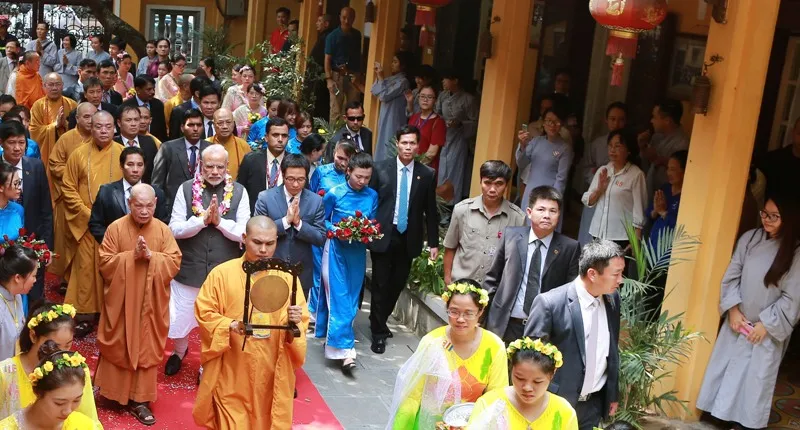-
CENTRES
Progammes & Centres
Location
An important element of the Act East policy is using cultural diplomacy to further India’s interests.

Prime Minister Narendra Modi’s recent visit to Vietnam and to Laos this week to participate in the India-ASEAN Summit have further strengthened New Delhi’s bilateral ties with Hanoi and the Southeast Asian regional bloc ASEAN.
An aspect of these visits that also needs to draw attention is New Delhi’s renewed diplomatic focus on the Mekong sub-region — an area of increasing geopolitical competition among major powers, including China, the US, India and Japan, as their interests overlap and intersect in this sub-region.
The Mekong sub-region or what the Indian government calls the CLMV countries (Cambodia, Laos, Myanmar, and Vietnam) forms a major part of mainland Southeast Asia and connects the Bay of Bengal to the South China Sea by land.
For India, the strategic salience of the sub-region lies in the fact that it shares long land and maritime boundaries with one of the CLMV countries, Myanmar in the Bay of Bengal, and its important strategic partner, Vietnam, has maritime territorial dispute with China in the South China Sea — through which about 50 percent of India’s trade passes.
In recent years, the direct impact of China’s rise has been playing out in the CLMV countries with China emerging as the largest (or a major) trading and investment partner of all the CLMV countries. As China’s wealth spread to its immediate peripheries, poorer and smaller nations in the Mekong sub-region are being drawn towards the Chinese economy.
On the strategic front, Beijing has been taking advantages of the geostrategic location of the CLMV countries to reach the Indian Ocean, and to tie their economies with its bigger and stronger economy by building rail and road networks and laying energy pipelines.
China also plans to connect its southwest Yunnan provincial capital of Kunming with Southeast Asian nations with new high and medium-speed rail services. In November last year, Laos signed a railway deal to connect the Laotian capital Vientiane with Kunming. The line is expected to be completed by 2020 with work on the Chinese side already underway since last December.
Another rail line will run from Kunming to Vietnam and Cambodia. China has already built oil and gas pipelines running from the Bay of Bengal to Yunnan through Myanmar and it plans to build rail and road along the pipelines. These corridors are part of the China-proposed One Belt, One Road (OBOR) initiative and form the "Indochina Peninsula Corridor", one of the six trans-regional economic corridors of the OBOR.
Importantly, all the CLMV countries have given official assent to the initiative with varying degrees of support. Laos and Cambodia have been most supportive of the OBOR. Myanmar has joined them recently during its State Counsellor and Foreign Minister Aung San Suu Kyi’s visit to China.
Despite its official statement to go along with the OBOR, Vietnam has been the least supportive. As China creates more corridors with and through the CLMV countries, its political and economic clout in this sub-region is going to grow further. The emerging Chinese-initiated corridors have the potential of further tying the strategic interests of the Mekong nations to China’s interests.
With his visit to Laos now, Prime Minister Modi has travelled to all the CLMV countries except Cambodia. In November 2014, Modi visited Myanmar to participate in the India-ASEAN Summit during which he unveiled the Act East policy.
Since coming to power, the Modi government has been giving a renewed push to strengthen ties with CLMV nations. Recognising the rapidly changing regional dynamics and the need for India to step up its role and presence, the Modi administration has prioritised Delhi’s engagement with the leaders of the CLMV nations.
Modi has already hosted two leaders from the CLMV nations. President Htin Kyaw of Myanmar visited Delhi a week back and held bilateral discussion with the Indian leadership. Vietnamese Prime Minister Nguyen Tan Dung visited India in October 2014. During his recent visit to Hanoi, Modi and his Vietnamese counterpart decided to further expand and deepen their strategic partnership. Several important bilateral MoUs and agreements have been reached on a range of areas including defence, trade, connectivity, etc during these high-level visits.
An important element of the Act East policy is using cultural diplomacy to further India’s interests. Buddhism is the predominant religion of all the CLMV countries and Modi has been tapping the rich Buddhist connection between India and the CLMV nations. Like most of the leaders from the CLMV nations, President Kyaw of Myanmar and Vietnamese Prime Minister Nguyen visited the most revered place for the followers of Buddhists — the Bodh Gaya in Bihar during their India visits.
Importantly, last month the Modi cabinet cleared a proposal to create a $75 million project development fund to increase Indian economic presence in CLMV countries. This fund is aimed at driving Indian investment in the Mekong sub-region. Earlier, in November 2015 at the India-ASEAN Summit, Modi announced a new $1 billion fund to boost physical and digital connectivity between India and ASEAN nations.
Bilateral trade between India and the CLMV nations has grown from $0.46 billion to over $11 billion 2014 registering an annual growth of 24 percent. According to the study by the Indian ministry of commerce, there is a potential of about $100 billion of additional exports to the CLMV countries.
Recognising the trade potential, an India-CLMV business conclave has been established in 2013 to create and provide a platform for decisions makers and industry leaders to meet and identify opportunities for collaboration. The third conclave was held in January this year where Indian commerce minister stressed the need for better connectivity and enhanced economic integration with regional value chains.
India’s diplomatic interest in the CLMV countries was never lost, as is evident in the existence of the CLMV division in its foreign office or the establishment of sub-regional bloc called Mekong-Ganga Cooperation (MGC) in the year 2000. However, the Mekong sub-region has hardly taken the centre-stage in Delhi’s foreign policy priorities. Modi is changing this narrative by placing the Mekong sub-region among his top diplomatic priorities.
As Modi sets the direction, the challenge is in sustaining the focus and ensuring that the initiatives are effectively implemented on the ground. In fact, a practical way of keeping it a foreign policy priority may be to upgrade the MGC annual ministerial meeting to summit level (if not annually, biennially), similar to what India as with another sub-regional grouping BIMSTEC (Bay of Bengal Initiative for Multi-Sectoral, Technical and Economic Cooperation). This will boost India-CLMV ties in a major way.
The views expressed above belong to the author(s). ORF research and analyses now available on Telegram! Click here to access our curated content — blogs, longforms and interviews.

K. Yhome was Senior Fellow with ORFs Neighbourhood Regional Studies Initiative. His research interests include Indias regional diplomacy regional and sub-regionalism in South and Southeast ...
Read More +